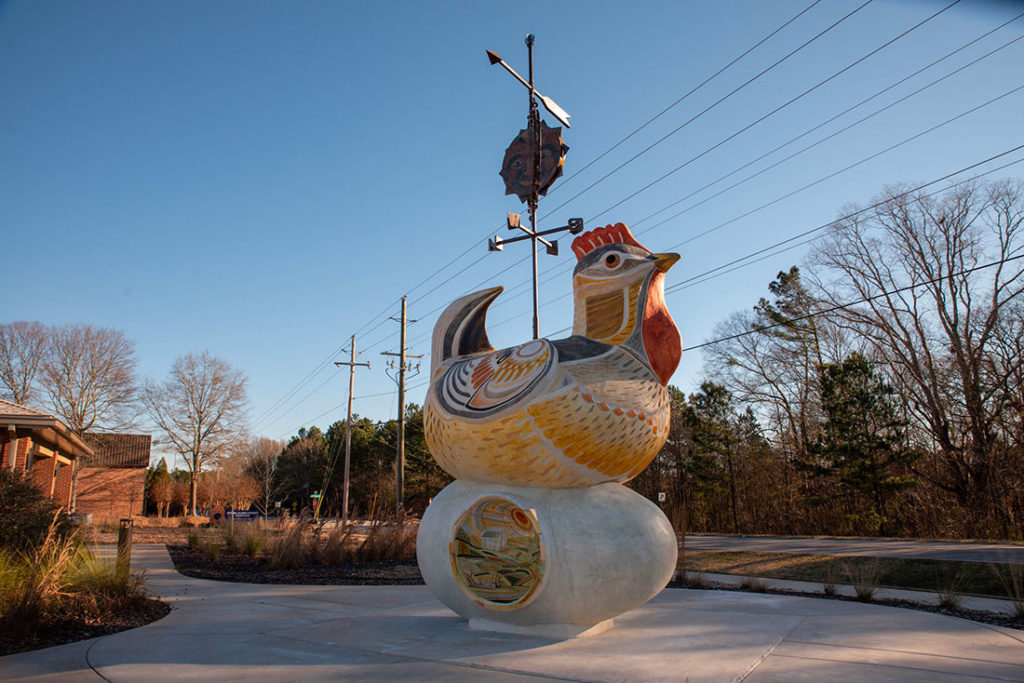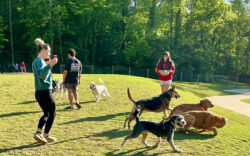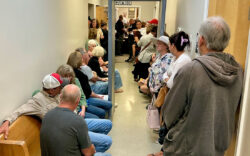A sculptural installation vandalized twice in downtown Athens is just one of around 200 publicly owned art pieces in Athens-Clarke County. A recent art inventory of Athens-Clarke public art identified 198 pieces—paintings in buildings, 60 bus shelters that combine art and function, murals on buildings, signature pieces like the statue of Athena at the Classic Center and the “Origins” chicken-and-egg painted sculpture on Cleveland Road that’s already a community favorite, and dozens more. The number is probably an undercount, said Athens-Clarke County Leisure Services Director Kent Kilpatrick, whose department is charged with taking care of all that art.
Those dozens of projects rarely draw much negative attention, but the many critics of “Frequency,” the “blue squiggle” sculptures that generated controversy when installed on Clayton Street last December, raised questions about the process for choosing and funding public art.
Pennies Add Up
A lot more public art is on the way. Back in 2010, the ACC Commission adopted a task force recommendation to devote 1% of its capital expenditures to public art. One percent may not sound like much, but ACC spends a lot of money on capital projects, mainly funded by two 1% sales taxes, the Special Option Local Sales Tax and the Transportation Special Local Option Sales Tax.
In 2019 voters overwhelmingly approved continuing the penny SPLOST tax to fund an 11-year, $314 million slate of SPLOST projects, including $44 million for affordable housing, $78 million for a new courthouse, $14 million for an Eastside public library and $34 million to partially fund the Classic Center arena project now taking shape. Just last year, voters said yes by a wide margin to a $150 million, five-year extension of TSPLOST. Even discounting the kinds of projects that might not lend themselves easily to a public art component—$6.5 million for broadband enhancement, for example—ACC will spend millions of dollars on new public art in the next decade.
A fairly large chunk of that art spending is coming up soon: three projects slated for the Classic Center Arena, one of the first of the SPLOST projects to get underway. Last month, the Athens-Clarke government issued a call for qualifications, advertised nationally, for artists who’d like to compete for the three projects: a sculptural piece for an outside plaza ($200,000); a wall-mounted, landscape scale piece for an exterior wall ($70,000); and a large-scale mural or mosaic “celebrating Georgia music history” for the arena’s interior entryway ($50,000).
The ACC Commission ultimately decides yes or no on art projects. But it’s county staff and the volunteer Athens-Clarke County Cultural Affairs Commission that facilitate the process of getting a proposal to the commission.
With SPLOST projects, a so-called user group first decides what type of art and where it will be. In the case of the 5,500-seat Classic Center arena, it’s a six-member group that includes Classic Center Executive Director Paul Cramer, but others appointed by the county manager, such as Katherine Stein, director of the University of Georgia’s Hargrett Rare Books and Manuscripts Library; and Athens musician, producer and music engineer David Barbe, director of the University of Georgia’s Music Business Certificate Program.
Once type and site are decided, ACC arts administrators put out a call for artists interested in undertaking the project, then winnow applicants to a few finalists who are asked to submit more detailed proposals. Because public art is a specialized field, the applicants are often artists from elsewhere who travel the region or the country full-time painting murals or installing sculptures, rather than local artists, although Athens-based artists like David Hale, Krysia Ara, Harold Rittenberry and Robert Clements have been chosen for some projects.

A “public art selection panel,” a group that typically meets one time, then reviews the detailed proposals and chooses one to submit to the Cultural Affairs Commission, which sends its recommendation on to the ACC Commission for approval. The selection panels, appointed by the Cultural Affairs Commission, can include not only ACC staff and Cultural Affairs Commission members, but also volunteers who simply want to have a part in the decision. There is no set size for the groups, which pick blind—they don’t know the name of the artists submitting the proposals or where they’re from.
The ACAC needs more volunteers, both for the selection panels and for the 11-member commission itself. The ACC government put out a call last month for applications to fill three vacancies. “It’s like pulling teeth to get the public involved,” Cultural Affairs Commission chair Helen Kuykendall said. “It would be so wonderful to have more people engaged.”
The selection panels “are actually quite fun,” said Kuykendall, who was on a four-person panel herself one night recently. From among four finalists, the panel unanimously endorsed one proposal.
What’s the Frequency?
The vandalized parts of the $50,000 “Frequency” sculpture will be restored, assuming the ACC Commission approves spending the money it will cost.
Designed by Annapolis, MD Chief of Comprehensive Planning Eric Leshinsky, the 14-piece work drew a flood of negative criticism on social media soon after it was installed. Some accurately predicted a dire fate for the pipes, coated a deep metallic blue. “When UGA wins the national championship again, this thing will probably get ripped out of the ground (or bent into a pretzel) and disappear,” wrote one prescient Reddit commenter in early December.
“All it takes is for a scrapper to realize that these are made of aluminum. And he has a battery-powered Sawz-All. In less than 60 seconds… he’ll be off with the goods to the recycling center,” according to another Reddit post.
On about Dec. 16, little more than a week after the sculpture was dedicated, someone did use something like a Sawz-All to remove one of the smaller segments that had divided a downtown public bench. Police have not identified a suspect.
Then on Jan. 9, drunken revelers who flooded downtown Athens after UGA’s football team won the national championship game took down “Frequency”’s two larger looping segments at the Clayton Street intersections with College Avenue and Lumpkin Street.
Arts staff and the Cultural Affairs Commission are recommending reinstalling the vandalized parts of “Frequency” in their original locations, with stronger moorings for the two taller segments, and shifting the location of the smaller piece to the side of the bench.
The replacement parts will have to be fabricated anew; the downed pieces are too damaged to repair and recoat, ACC Public Art Coordinator Tatiana Veneruso told the Cultural Affairs Commission at its February meeting. The cost remains to be determined, according to Kilpatrick.
Like what you just read? Support Flagpole by making a donation today. Every dollar you give helps fund our ongoing mission to provide Athens with quality, independent journalism.









